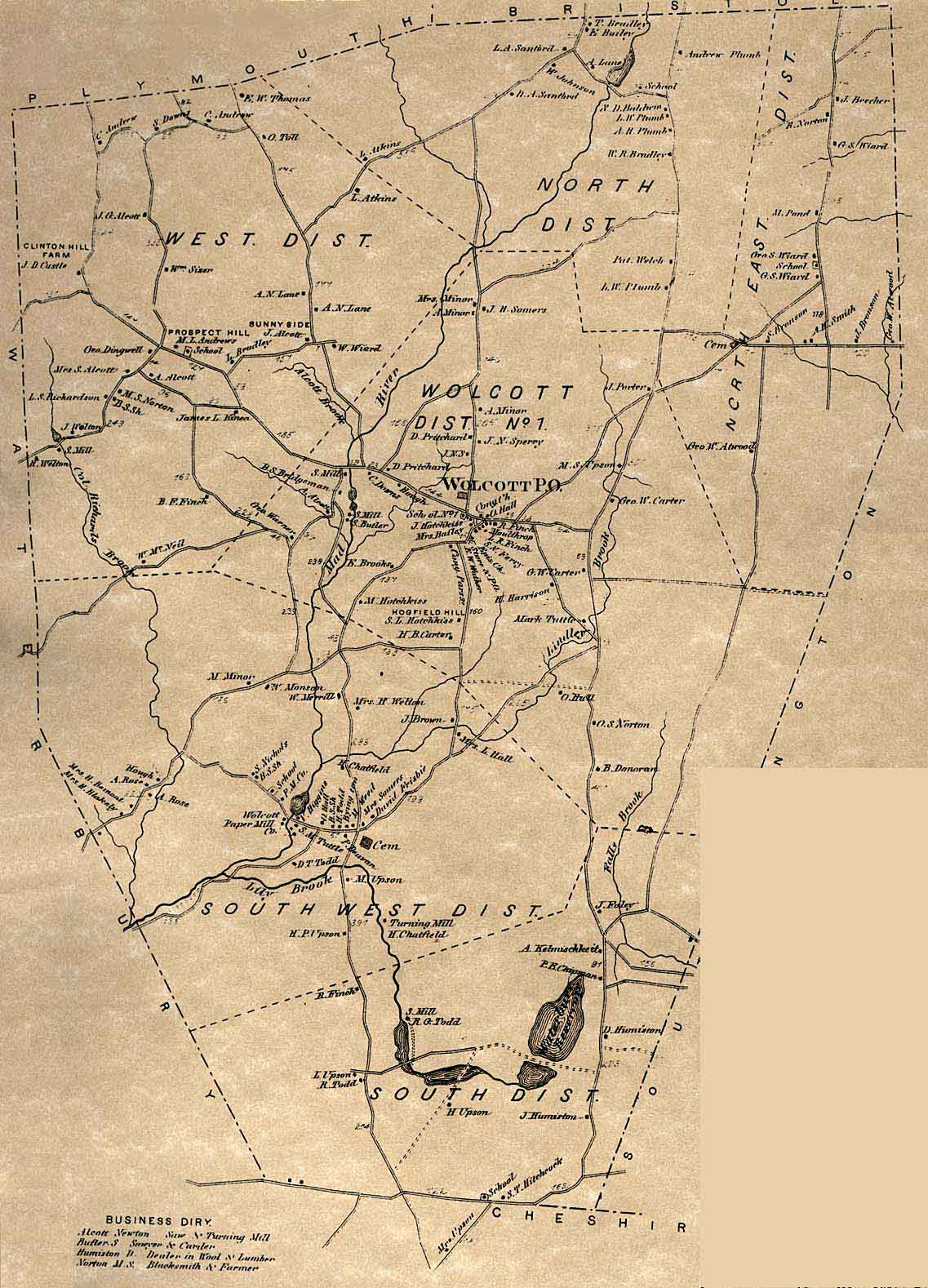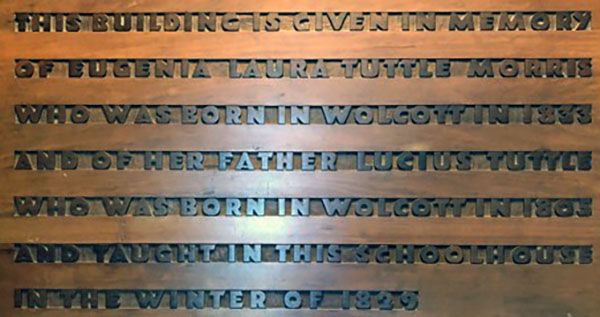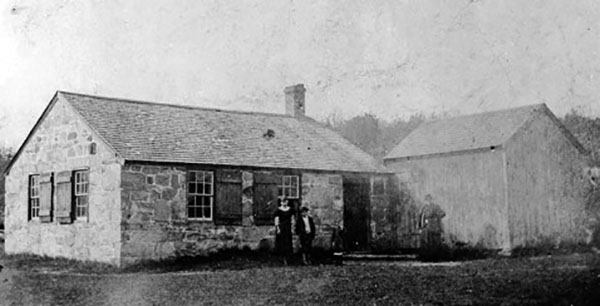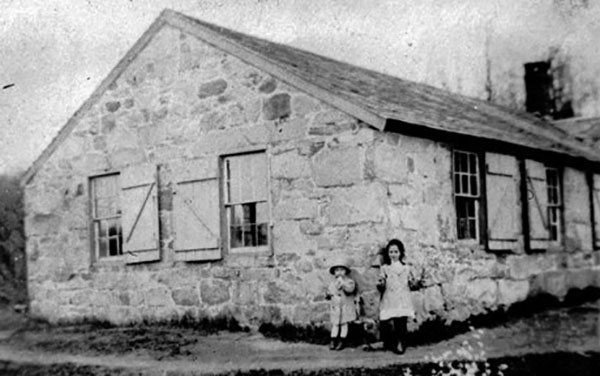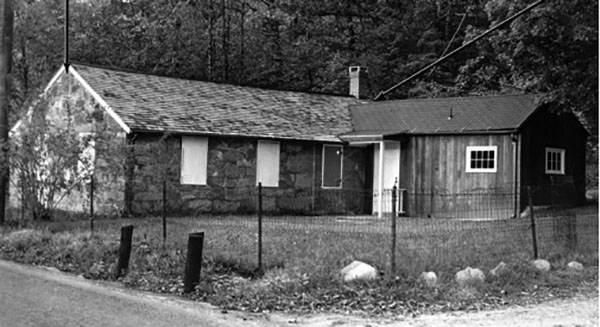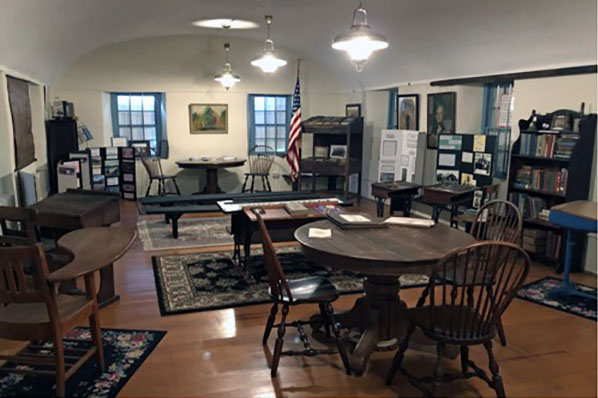|
|
||||||||||||
 |
 |
|
Wolcott Historical Society News - September 2021 By Florence Goodman This year our town is celebrating 225 years since its incorporation as well as a name change from Farmingbury to Wolcott. Our town has a rich history for which we should be quite proud. We can boast that two famous people were born and grew up in the Spindle Hill area of our town; clockmaker, Seth Thomas was born here in 1785 and Amos Bronson Alcott, educator, writer, philosopher and reformer born in 1799. This year also marks 200 years since our one room stone schoolhouse, which now serves as The Wolcott Historical Society's Schoolhouse Museum was built on Nichols Road. October 16th and 17th are the days dedicated to our 225th Celebration, which should prove to be fun for all ages, but this month I'd like to focus on the history of our stone schoolhouse.
I recently came across the "Story of The Old Stone School" written by John H. Washburne circa 1959. John served as the town historian as well as president of the Wolcott Historical Society for many years, but what I remember most about John and his wife Katherine was their love of Wolcott history and their desire to share it, so I would like to add to my previous articles about this schoolhouse with some new information from John's article.
The history of education in our town was established at a General Assembly of the Governor and the Company of the Colony, which convened in New Haven on the second Thursday of October in 1770. At this meeting "the Farmingbury winter-parish was granted a district or separate Ecclesiastical Society together with the right to establish school districts."
On November 13th of that year a school committee and sub-committer were established and at a later date the "parish" was divided into school districts. (It's important to note that the term 'parish' is used in early history because there was no separation of church and state.) Originally there were nine school districts, but later cut down to six. Each school district was responsible to collect their "poll rate" or head count. Parents were required to pay for each child attending school in proportion to the total number of students attending that school and the number of days in attendance. Not only were these fees almost impossible to calculate, but also they were even harder to collect.
These very early schools built in Farmingbury parish were crude log cabins with the openings filled with clay to keep out the cold. The fireplace and chimney were also made from logs and stuccoed with clay; this explains why there are none in existence today because they burned so easily.
The first school in the South West District was a log cabin built about 1771 and located at the top of the hill behind the present school. That location is according to Manville and Harvey Norton, father and son who both attended the Old Stone School. The original log structure was destroyed by fire circa 1820 and in 1821 the present stone structure was built. The stone for this building was quarried from the Wakelee Quarry located near the Waterbury line.
Each school district was examined and rated yearly by a visiting committee. In the fall of 1847 the school districts were chastised for not having enough furnishings, a woodhouse and outhouses. In 1882 a large woodshed was built by Dennis Pritchard and placed at a right angle at the exact northeast corner of the original building; this was done in the hope for an addition to the school in the future. In 1898 because of the overcrowded schools, a ten-foot addition was added to the original stone structure and the woodshed was attached for additional space; it also served as an enclosed entry and storage for students' belongings. The fireplace along the north end gable wall was demolished and a masonry chimney with flue was built for the new cast iron stove.
This Woodtick stone schoolhouse was used to educate the children who lived in the southwest section of town from 1821 to 1930 and then again from 1941-1942, thus educating children for 112 years. Many generations from the same families attended this school. Family members from Alcott, Brown, Frisbie, Hall, Norton, Todd, Tuttle, Wakelee, Archambault, Boulanger, Gaudiose, Herbst, Nigro, O'Conner and Rozdilski are just some that attended this school.
In 1930 the town voted to replace the old stone school with a new two-room brick school building called Woodtick School. In later years that newer two-room Woodtick School was turned over to the Public Safety Department and later demolished to make room for the current structure.
The old stone schoolhouse was sold in 1931 to Miss Emily Morris; three years later she donated the school to the Mattatuck Historical Society of Waterbury. Miss Morris wanted the school to be a memorial to her mother Eugenia Laura Tuttle Morris and her maternal grandfather Lucius Tuttle who had taught in the school in 1829.
In 1941-42 the town leased the building and reopened it for several years to take care of the overflow from the new Woodtick School. Later the building was vandalized and the Mattatuck Historical Society's plan to restore it became too costly, thus some changes were made to allow for living quarters for a caretaker.
In 1962 the school was turned over to the newly formed Wolcott Historical Society. The museum was opened in 1963 and has served as such for fifty plus years. In 1978, Mr. John Washburne applied for historic status for the building, but it wasn't until 1982 that it was placed on the National Register of Historic Places.
In 1989 the schoolhouse received several much need renovations. A new cedar shingle roof replaced the old leaking roof, the old chimney was rebuilt, the concrete floor was replaced with wooden planking, and a drainage system was installed around the exterior of the building. They also removed a small porch that had been added to the entrance of the building to bring it back to its original state. In 2010 the cedar roof once again needed to be replaced and later sealed.
In 2017 the Society received a 50/50 grant from the CT Trust to complete a Needs Assessment Report of the building. This report was completed by Ames & Whitaker Architects and listed extensive and costly repairs that were needed to preserve the building. The number one priority was to remove an old window air conditioner and replace it with two humidifier/air conditioning heat-pump units needed to remove the moisture from the building. These were installed in November of 2017. In August of 2018 the front door and jamb were replaced and later the stucco interior repairs and painting were completed. The outside masonry was repointed and the roof was sealed once again. In 2020 the exterior of the building, the shed and garage were painted. Maintaining a 200-year-old building is not an easy task, but the Society with the help of the town has proven that it can be done. We hope you will stop by to visit during our October celebration and enjoy some of our local history.
(Information for this article was taken from "Wolcott, Connecticut 175th Anniversary 1796-1971," by John H. Washburne; "A Salute To Two Centeries of Education IN WOLCOTT, Connecticut," "The Old Woodtick School in Wolcott, A Report on Its Present Condition;" "Story of the Old Stone School," by John Washburne, circa 1959)
An 1868 map showing the school districts in Wolcott.
The plaque donated by Miss Emily Morris explaining why she bought the stone school.
The Stone Schoolhouse prior to 1898. The teacher is standing in front of the wood shed.
The Stone Schoolhouse after the 1898 addition.
The Stone Schoolhouse when it was used as a residence, sometime after 1942.
This is a view of the inside of the Wolcott Historical Society's Stone Schoolhouse Museum.
To view past installments of the Historical Society News, click here. |
|
|
[Home]
[News]
[Purpose]
[Calendar]
[Museum]
[Membership]
[History]
[Contacts]
[Links]
All material at Wolcott Historical Society Web sites Copyright © 2000-2021 Wolcott Historical Society |
